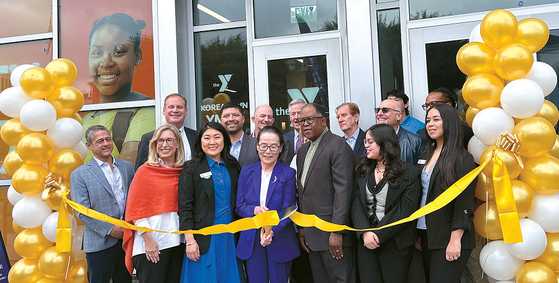The opening ceremony of the Koreatown YMCA Center (433 S. Vermont Ave.) on February 27 was marked by a sense of bittersweetness. KYCC Director Steve Kang, while enthusiastically clapping his hands, repeatedly expressed his sentiment, saying, “It’s a pity.”
The new building stands as a sleek and pristine addition to the community. However, what imbues Kang’s emotions with bitterness is the history tied to this location eight years ago. The YMCA Center building that now graces Vermont Street was initially designated to be the LA Koreatown Community Center.

Behind the opening ceremony lies a narrative reflecting the intricacies of the Korean-American community, which, at that time, was grappling with a lack of cohesive leadership and momentum.
It was August 9, 2016, when the LA County Board of Supervisors formally embraced a proposal to erect a 12,500-square-foot community center led by the Korean American community on this very site.
This decision integrated the plan into the broader redevelopment project of the Vermont Corridor, spanning from 4th to 6th Street on Vermont Avenue, championed by the county government at the time.
The occasion marked a historic milestone for many, signifying the culmination of relentless advocacy efforts by the Korean-American community to establish a central hub in Koreatown. Mark Ridley-Thomas, the supervisor who was in charge of Koreatown at the time, also lent his support to the idea.
At the forefront of the push for a community center in Koreatown stood the Koreatown Arts & Recreation Center (K-ARC), a coalition comprising 10 Korean-American organizations, including KYCC (Koreatown Youth + Community Center), KFAM (Korean American Family Services), KAFLA (Korean American Federation of Los Angeles), KACCLA (Korean American Chamber of Commerce of Los Angeles), PAVA (Pacific American Volunteer Association), and FACE (Faith and Community Empowerment).
The project possessed all the necessary components, including land and building infrastructure, with the government committed to covering the expenses. Additionally, operating funds totaling $1 million were donated in 2011 by developer company JH Snyder, engaged in constructing a large mixed-use building at Wilshire and Vermont. All that was required was a concerted effort to materialize and establish the center.
However, the project’s downfall was primarily attributed to the failure of the community to designate a representative body.
“At the time, the government had one condition for us, which was that K-ARC would choose a ‘representative group’ to run the community center,” said an official from a Korean-American organization who asked for anonymity. “However, the process eventually stalled because K-ARC could not reach a consensus.”
The LA County Board of Supervisors eventually opted to appoint the YMCA to operate the community center and administer community service programs.
Originally envisioned by the Korean-American community, the community center was intended to serve as a cultural and recreational hub, offering arts programs, sports facilities, and free access to all Koreatown residents.
However, with the YMCA assuming control, the focus shifted towards specific services like sports and fitness, operating under a membership system that entails a fee, although one that is considered affordable.
When the YMCA decided to take over, the Korean-American community’s idea was put on the back burner.
“The opening of the YMCA building is something to celebrate, but it’s also bittersweet,” Kang said, adding, “It’s a pity for the Korean-American community that the center was not built, as it was achieved through grassroots campaigns and participation in public hearings.”
Despite the passage of eight years, the Korean-American organizations of K-ARC continue to convene on a quarterly basis, and the $1 million operating fund remains untouched in the bank.
Eight years later, nothing has changed. What has changed is that the building that was supposed to be the Koreatown Community Center now has a ‘YMCA’ sign. Many Korean Americans still would not know why the sign was changed.
BY YEOL JANG, HOONSIK WOO [jang.yeol@koreadaily.com]




